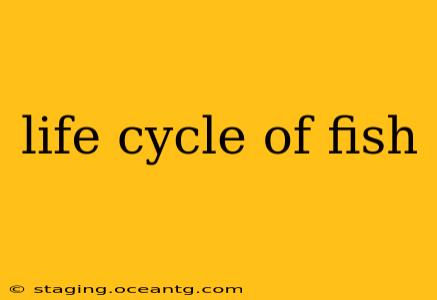Fish, the dominant vertebrates in our aquatic ecosystems, exhibit a fascinating diversity in their life cycles. While the general pattern involves eggs, larvae, juveniles, and adults, the specifics vary dramatically across the thousands of fish species. Understanding this life cycle is crucial to appreciating their ecological roles and conserving these vital populations.
What are the stages in a fish's life cycle?
The fish life cycle is broadly divided into several key stages:
1. Egg Stage: The life cycle begins with eggs, often laid in large quantities. These eggs can be pelagic (floating freely in the water column), demersal (resting on the bottom), or attached to vegetation or other substrates. The number of eggs produced, their size, and the level of parental care vary considerably depending on the species. Some species, like salmon, invest heavily in a smaller number of larger, more nutrient-rich eggs, while others, like many bony fish, release millions of tiny eggs with a lower survival rate.
2. Embryonic Stage: Inside the egg, the fertilized egg develops into an embryo. This stage involves rapid cell division and differentiation, forming the basic body plan of the fish. The duration of this stage depends heavily on water temperature and species, ranging from a few days to several weeks.
3. Larval Stage: Once the embryo completes its development within the egg, it hatches into a larva. Fish larvae are typically very different from their adult forms, often possessing specialized structures for feeding and survival in their planktonic environment. They are often small and transparent, relying on yolk sacs for initial nutrition before transitioning to active feeding. This stage is characterized by rapid growth and significant morphological changes as the larva develops into a juvenile.
4. Juvenile Stage: As the larva grows, it transitions into the juvenile stage. This involves a gradual transformation into the adult form, with the development of fins, scales, and other adult features. Juveniles are still relatively small and vulnerable but are now actively feeding and exhibiting more complex behaviors.
5. Adult Stage: Finally, the fish reaches adulthood, marked by sexual maturity and the ability to reproduce. Adult fish exhibit their full size and characteristic features, playing their role in the ecosystem as predators, prey, or both. Their lifespan varies greatly among species, from just a few years to over a century.
What are the different types of fish reproduction?
Fish reproduction strategies are remarkably diverse, adding another layer of complexity to the life cycle. Some key methods include:
- Oviparity: This is the most common type of reproduction, where eggs are laid externally and fertilized externally.
- Viviparity: In this case, the eggs develop internally, and live young are born.
- Ovoviviparity: Here, eggs develop internally, but the young receive nourishment from the yolk sac and are born live.
How long does it take for a fish to grow to full size?
The time it takes for a fish to reach full size varies immensely depending on the species. Some small fish may reach maturity in a matter of months, while others, like certain sharks and deep-sea fish, may take years or even decades to reach their adult size. Factors such as water temperature, food availability, and genetic factors all influence growth rates.
What are the threats to fish life cycles?
Numerous threats jeopardize fish life cycles, impacting their survival and abundance:
- Habitat loss and degradation: Pollution, dam construction, and coastal development significantly affect fish spawning grounds and nursery habitats.
- Overfishing: Unsustainable fishing practices deplete adult populations, reducing the number of individuals available for reproduction.
- Climate change: Changes in water temperature, ocean acidification, and altered precipitation patterns disrupt various aspects of the fish life cycle.
- Invasive species: Non-native species can outcompete native fish or prey upon their eggs and larvae.
Understanding the intricacies of fish life cycles is vital for effective conservation efforts. By acknowledging the diversity and complexities of these cycles and the threats they face, we can better protect these vital components of our aquatic ecosystems.
